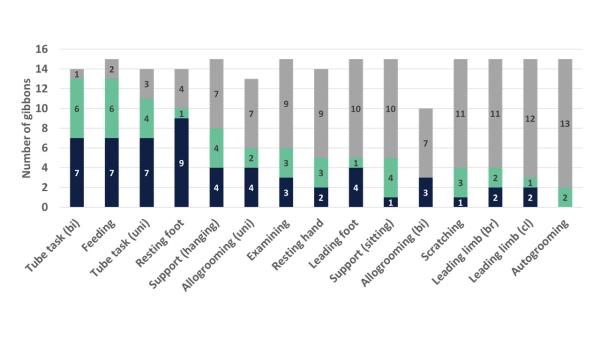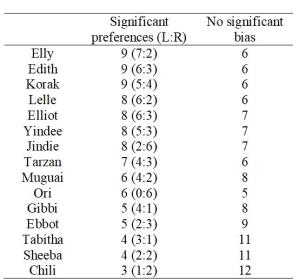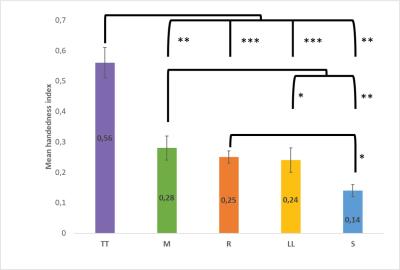Results
Summary of the results
Significant side preferences at the individual level were found within all 15 studied motor patterns (figure 1). However, no population-level side bias was found for any of the spontaneously occurring or task-related motor patterns and none of the gibbons were consistent in their hand preference across all motor patterns. However, there was a trend (p=0.070) for the gibbons to be consistent in their hand use for feeding, unimanual tube task, and bimanual tube task. The strength of hand preference was significantly stronger for the tube task than for all the spontaneously occurring behaviors.

Detailed results
Spontaneously occurring behavior
The gibbons displayed no population-level side bias for any of the 13 spontaneously occurring motor patterns. However, for some of the motor patterns, the proportion of significant hand preferences was higher than for others (figure 1).
The motor pattern that elicited the highest proportion of hand preferences was feeding, here, 13 of the 15 gibbons (86.7%) had a significantly preferred feeding hand. The motor pattern with the lowest number of significant hand preferences was autogrooming. For this behavior, only two of the 15 gibbons had a significantly preferred hand (13.3%).
For resting foot, ten out of 14 gibbons had a significantly preferred foot. Of these ten gibbons, nine preferred the left foot. Although there was no population-level side bias, a significant majority was left-preferent (p=0.021), when only the gibbons with a significant foot preference were considered.
Tube task
No population-level side bias was found for either the unimanual- or the bimanual tube task. However, both motor patterns elicited high proportions of significant hand preferences. Of the 14 gibbons that participated in the tube task, 11 (78.6%) had a significant hand preference for the unimanual tube task and 13 (92.9%) for the bimanual tube task (figure 1).

Consistency of hand preference
None of the 15 gibbons displayed a consistent left- or right-side bias across all 15 motor patterns. Rather, all animals displayed a significant side bias for some of the motor patterns and all except one (Ori) displayed a switch of the preferred side between the observed behaviors.
To investigate if the gibbons displayed a consistent preference across motor patterns that were similar to each other, consistency within the five behavioral categories was examined.
Manipulation
Of the 15 gibbons, seven animals were consistent in their side bias for manipulation. Four gibbons had at least one significant preference for the left as well as the right hand and thus displayed a switch of the preferred side within this category. The remaining four gibbons displayed no significant hand preferences for this category, or just for one motor pattern.
Leading limb
In this category, two of the 15 animals displayed a significant hand preference for two of the three motor patterns both were consistent in the side of their preference. All other 13 gibbons either displayed no significant preference at all or just for one of the three motor patterns.
Supporting hand
Four of the animals were consistent in their side bias within the supporting hand category and significantly preferred the same hand for holding when hanging or sitting. The other 11 gibbons displayed no significant preference for either of the two motor patterns or just for one of them.
Resting position
Two animals were consistent in their side bias across the two behaviors and two displayed a switch of preferred side. For one gibbon, no data were available for this category.The ten remaining animals displayed no significant side bias at all or just for one of the two motor patterns.
Tube task
Of the 14 gibbons that participated in the tube task, ten animals were consistent in their side bias and thus significantly preferred the same hand for both the unimanual and the bimanual tube task. The four remaining gibbons, only displayed a significant side bias for one of the tube task motor patterns.

Spontaneously occurring behavior versus task-related behavior
The motor patterns with the highest proportions of significant hand preferences were feeding, the unimanual-, and the bimanual tube task. For all other spontaneously occurring motor patterns, the number of gibbons with a significantly preferred hand was too low, thus these behaviors could not be statistically compared to the tube task
Of the eight gibbons that had a significant hand preference for feeding and both the unimanual and bimanual tube task, seven significantly preferred to use the same hand across all three motor patterns (table 2). Accordingly, there was a non-significant trend to use the same hand for all three motor patterns (p=0.070).

Mean strength and direction of hand preference
Strength of side preference was significantly higher for the tube task category than for manipulation (p=0.0021), leading limb (p=0.00037)), supporting hand (p=0.0011), and resting position (p=0.00024). Side preferences for manipulation and resting position were significantly stronger than those for supporting hand (p=0.0043 and p=0.014, respectively). Additionally, the preferences for manipulation were significantly stronger than those for leading limb (p=0.043) (figure 2).
For the bimanual tube task, females had a significantly stronger hand preference for supporting hand than males (p=0.039). Although the females tended to also display a stronger side bias for the tube task than the males, this difference was not significant (p=0.051).
In the bimanual tube task, females displayed a tendency towards a left-side bias, while males tended to display a bias to the right (table 3). However, possibly due to the large degree of interindividual variation, this difference between sexes was not significant (p=0.081).

Responsible for this page:
Director of undergraduate studies Biology
Last updated:
05/18/21
